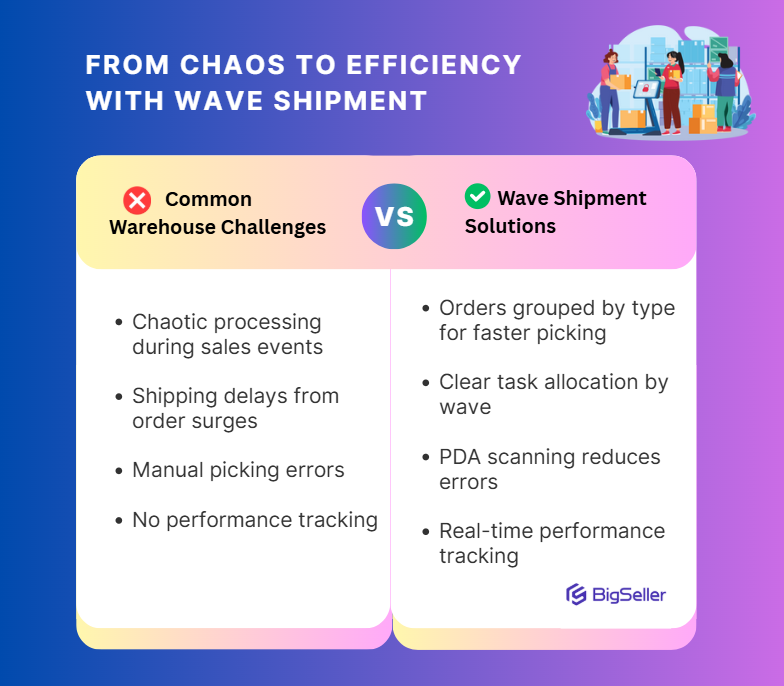Inventory mistakes cost more than just time. One wrong stock count can lead to overselling, unhappy customers, and account penalties on marketplaces. This is where sellers usually ask: Should I keep doing this manually or switch to a warehouse management system (WMS)?
This article breaks down both approaches, manual inventory vs WMS, based on real seller workflows. Whether you're still small or starting to scale, this will help you choose the right system to manage your stock more efficiently.
What is Manual Inventory Management?
Manual inventory management is when you track your product stock without using advanced software systems. Instead, you manage inventory using basic tools like:
-
Paper records or notebooks: physically writing down how many items you have.
-
Excel or Google Sheets: creating spreadsheets to list SKUs, stock levels, etc.
-
Verbal updates or digital notes: telling team members or recording small changes through informal means (like WhatsApp or Notepad).
This method is common among small or home-based businesses, especially when there are only a few products or sales each day.
What is a Warehouse Management System (WMS)?
A WMS is a software tool that helps sellers manage everything that happens inside a warehouse or stockroom, from receiving items to shipping them out.
It’s used to track inventory more accurately, speed up the picking and packing process, and connect with sales channels like Shopee, Lazada, and TikTok Shop. Instead of relying on manual tracking, the system automatically updates your stock in real time.
A WMS helps you manage:
-
Inventory locations: Know exactly where each item is stored (e.g., which shelf or rack).
-
Real-time stock levels: Your inventory is updated automatically as orders come in.
-
Order fulfillment: Create picklists, pack orders, print labels, and ship more efficiently.
-
Sales sync across platforms: Automatically connects to marketplaces so you don’t have to update stock manually for each platform.
It becomes especially useful when:
-
You process 20–30+ orders daily
-
You have multiple team members handling stock
-
You sell across more than one online store or marketplace
A WMS doesn’t just help with stock accuracy, it also improves fulfillment speed across your entire operation. This guide shows how sellers are using WMS to fulfill 2x faster.

Signs You’ve Outgrown Manual Inventory Management
You don’t need high-tech software or complicated metrics to realise your current system isn’t cutting it. If you’re experiencing any of the following, it’s a strong sign that you should upgrade to a Warehouse Management System (WMS):
1. You're spending more time updating sheets than fulfilling orders
Instead of packing and shipping orders, you're stuck editing spreadsheets and checking stock manually. This is a red flag that your process is slowing you down.
2. Customers are complaining about missing or incorrect items
Mistakes happen more often with manual systems like sending the wrong product or not shipping because stock counts were wrong. These issues hurt your reputation and can lead to penalties on marketplaces.
3. Stock discrepancies are becoming a regular issue
You constantly find mismatches between what’s on your spreadsheet and what’s actually on the shelf. This leads to overselling, underselling, or needing last-minute fixes.
4. You're preparing for sales campaigns
When big sales are coming, you need a system that can handle higher volumes without crashing. Manual methods tend to break under pressure.
5. You're expanding to more marketplaces or sales channels
Managing stock across Shopee, Lazada, TikTok Shop, and your own website manually becomes too messy. You need a centralised system that can auto-sync stock in real-time.

Ready to Move Beyond Spreadsheets?
At a certain point, managing inventory with spreadsheets and handwritten notes becomes less about control and more about surviving the day-to-day. When orders increase, mistakes multiply. Stock counts get messy. Fulfillment slows down. And your team spends more time fixing issues than moving forward.
That’s when it makes sense to stop patching the process and replace it with something built for scale.
A Warehouse Management System (WMS) gives structure to what used to be guesswork. It turns picking, packing, and tracking into coordinated tasks. It replaces reactive routines with real-time updates. And it helps growing sellers handle volume without sacrificing accuracy or speed.
BigSeller WMS is one of the few tools that balances ease of use with powerful features from inventory sync, barcode scanning, multi-store support, and performance tracking, all in one system.
If your current workflow feels stretched thin, it might not be your team. It might be your tool.

Start using BigSeller WMS today and let your operations grow as confidently as your sales.
Follow our WhatsApp channel for tips on inventory control, marketplace strategies, and more.
